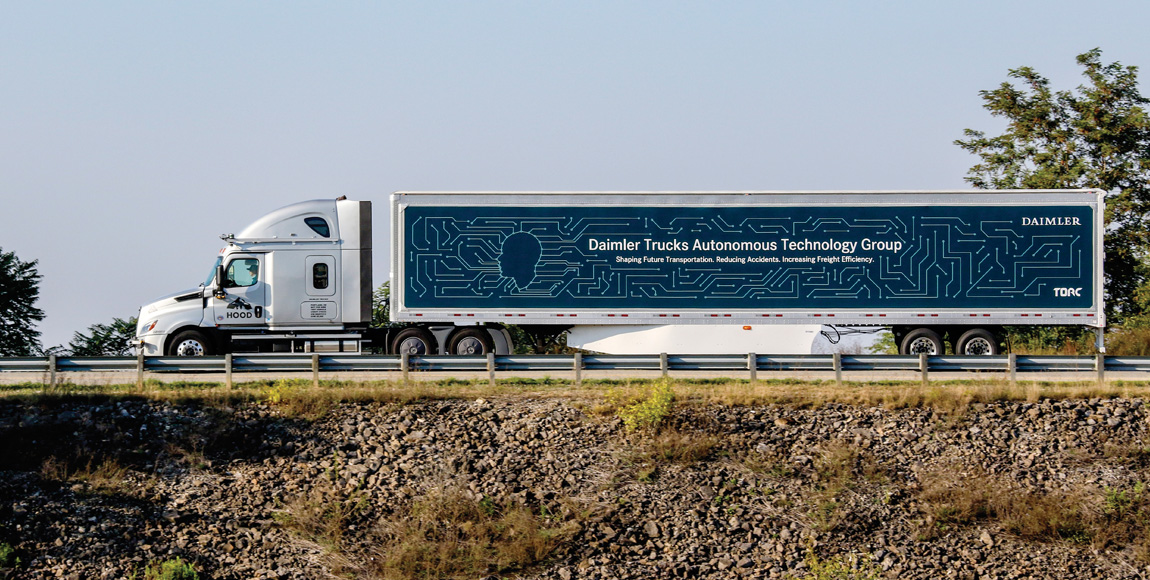Autonomy, here we come!

At the recent North American Commercial Vehicle Show in Atlanta, WILL SHIERS had the opportunity to catch up with Peter Schmidt, head of Daimler Trucks’ autonomous technology group, and Michael Fleming, president and CEO of Torc Robotics, a self-driving vehicle company in which Daimler has acquired a majority stake
Why is all the development work regarding autonomous trucks happening in the United States (US) and not in Europe?
Peter Schmidt (PS): The US offers us unique opportunities for testing. The sheer size of the country – 3 000 miles (4 828 km) coast to coast without any borders – lots of areas free of snow, a really strong economy and plenty of talent, too.
Also, there are more homogenous traffic flows. Trucks are allowed to travel as fast as cars here, whereas in countries such as Germany this is a nightmare. The differential speeds are huge, with trucks running at 80 km/h and passenger cars doing 200 km/h. So, it was a conscious decision to start here. Our customers here are big professional fleets, and they will be able to use this technology.
At what stage are you currently?
PS: We are in the testing phase. We did a lot of testing on the track in Virginia together with Torc, and since September we have been testing on public roads, but it is a long journey. It is a marathon and not a sprint, and it will be a long time until we see this product on public streets as a commercial product.
What sort of public reaction have you had?
PS: Everything we do is totally safe. We have trained safety drivers and there are always two people in the truck. We first did extensive testing on test tracks. We tested high-speed passing, merging from ramps, stopping for traffic jams and lost cargoes. We tested like hell before we went on to the public streets.
We met with the governor and with highway state police. Everything was really well prepared, including emergency plans. In the event, nothing happened. I think the reaction was positive. You can always find something negative online of course.

In countries such as South Africa, where there is massive unemployment, there is a real fear that autonomous trucks will lead to job losses. What has been the feedback from truck drivers?
PS: We have had very little negative feedback from truck drivers. You need to be realistic. This technology won’t be here in three years from now and won’t transform the industry overnight. The product we are developing will take a decade. You might see some pilots a little earlier, but they will be confined to specific areas.
Remember this is Level 4 and not Level 5. These trucks won’t be able to drive anywhere at any time. There will be a good manageable transition. It will be our job to really explain what this technology can do and its limits. Then people will realise that the impact on jobs will be far less dramatic than they think.
Michael Fleming (MF): This is disruptive technology that won’t be deployed overnight, and we are going to take a slow methodical approach to it. Part of the approach is to understand the customers’ requirements, and how we deploy this technology and balance safety, cost and performance. There is a great deal of excitement and fear over this technology, and part of our roll-out is to educate the public about the capabilities and limitations of the technology.
Is it correct to state that, within a decade, you will offer Level 4 long-haulage trucks that are able to go from hub A to hub B on the highway?
MF: Within 10 years we will be deploying self-driving trucks hub-to-hub on interstate and highway operations. It makes a great deal of sense. The business case is there. It is a much simpler problem than driving in urban environments. The US is dealing with a shortage of 100 000 drivers, which is expected to grow, but truck drivers do much more than just drive.
PS: That is an important point. The drivers will play an important role – first mile, last mile, customer interface and handling of the load, for instance.

Why did Daimler choose to partner with Torc Robotics?
MF: I think we both selected each other in this process. There are a couple of different reasons behind the decision. Torc is not a start-up. We have already been operating on public roads with Level 4 vehicles.
We have always taken a long-term approach and we focus on solving problems where there is a sound business case. We thought that the on-road, hub-to-hub business case was strong, so we went out to the original equipment manufacturers (OEMs) in the trucking space and we really found a cultural fit with Daimler.
Torc is a pioneer of self-driving technology. Daimler is a pioneer and inventor of the combustion engine and the truck, so our long-term approach to solving problems and creating impact was well aligned. A lot of companies try to solve very difficult problems overnight, but, as Peter rightly says, this is a marathon and not a sprint.
Along with a handful of other students, I started Torc with the purpose of commercialising this technology. We were definitely ahead of our time, and we really look forward to working with Daimler to create the greatest disruption in the trucking industry since the advent of the truck itself.
One of the big stumbling blocks with autonomy is liability. Who is responsible in the event of an accident?
MF: Right now, Torc is focused on ensuring that the truck doesn’t get into an accident. Safety is first and foremost. We are going through different scenarios and challenges that are faced by trucks on the road. The big challenge we have is what we call “bad actors” – cars and other vehicles doing things that they shouldn’t do.
If everyone obeyed the rules of the road, this is actually a fairly simple problem to solve, but what happens when you don’t just have one bad actor, but a cluster of bad actors?
MF: One of things I appreciate is that Daimler is the market leader. It means we are able to capture all those lessons learned, and the knowhow of the problems faced by truck drivers. Being able to take that back and look systematically at scenario A and B, and decide what a truck should do in scenario A and B to be safe, is invaluable.

What do you need from legislators to get the green light for an autonomous truck?
MF: In the US we have federal and state legislation. Daimler has a group of folks working with legislators at the federal and state level. We appreciate the fact that the legislators are not moving forwards too aggressively.
They are reaching out to organisations like Daimler and saying things like “help us to understand the capabilities and limitations of this technology so we can devise legislation that makes sense”. We are still in the early stages of legislation, but it is an industry/government partnership to roll out the right legislation at the right time.
Will we ever lose the steering wheel?
MF: I don’t think so, but I have learned to never say never.
PS: We are launching a Level 4 product. Level 5 means running autonomously anywhere, and at any time. You can remove the seat, the steering wheel and the cabin, but with Level 4 you need the driver as a back-up. And for the first and last-mile drivers will always be needed. This technology is not ready to be self-driving. It is not driverless.
MF: The difference between Level 4 and 5, is that Level 5 is outlined as being capable of driving in any situation. Hurricanes and snow
are very challenging conditions. For that reason, we
may never remove that steering wheel. A driver will have the responsibility to navigate in those challenging conditions.
PS: We need to wait and see how this technology evolves, and how we deploy it to the market. There are a lot or options and opportunities, and they will grow over time.
Are you even considering Level 5, or are you saying that this will never happen?
MF: We are targeting Level 4 as it makes the most sense. Based on its definition, you could argue that Level 5 is impossible.
PS: Driving in a city in a class 8 truck in fully autonomous mode is a really difficult problem, so why would you do it? There is no business case for it. Level 4 is a really hard nut to crack anyway – believe me!
MF: Imagine if we apply the Level 5 definition for a truck driver. Can a truck driver drive a truck in any condition imaginable? There we go!
A highly acclaimed trucking journalist, Will Shiers is editor of Commercial Motor and the United Kingdom jury member for the International Truck of the Year.
Torc Robotics
Torc Robotics was founded in 2005 by a group of students from Virginia Polytechnic Institute and State University. It initially concentrated on automation for farming, mining and military, but moved into self-driving cars two years ago. Although Daimler acquired a majority stake in Torc Robotics earlier this year, it retains its name, staff and identity.
Published by
Focus on Transport
focusmagsa




